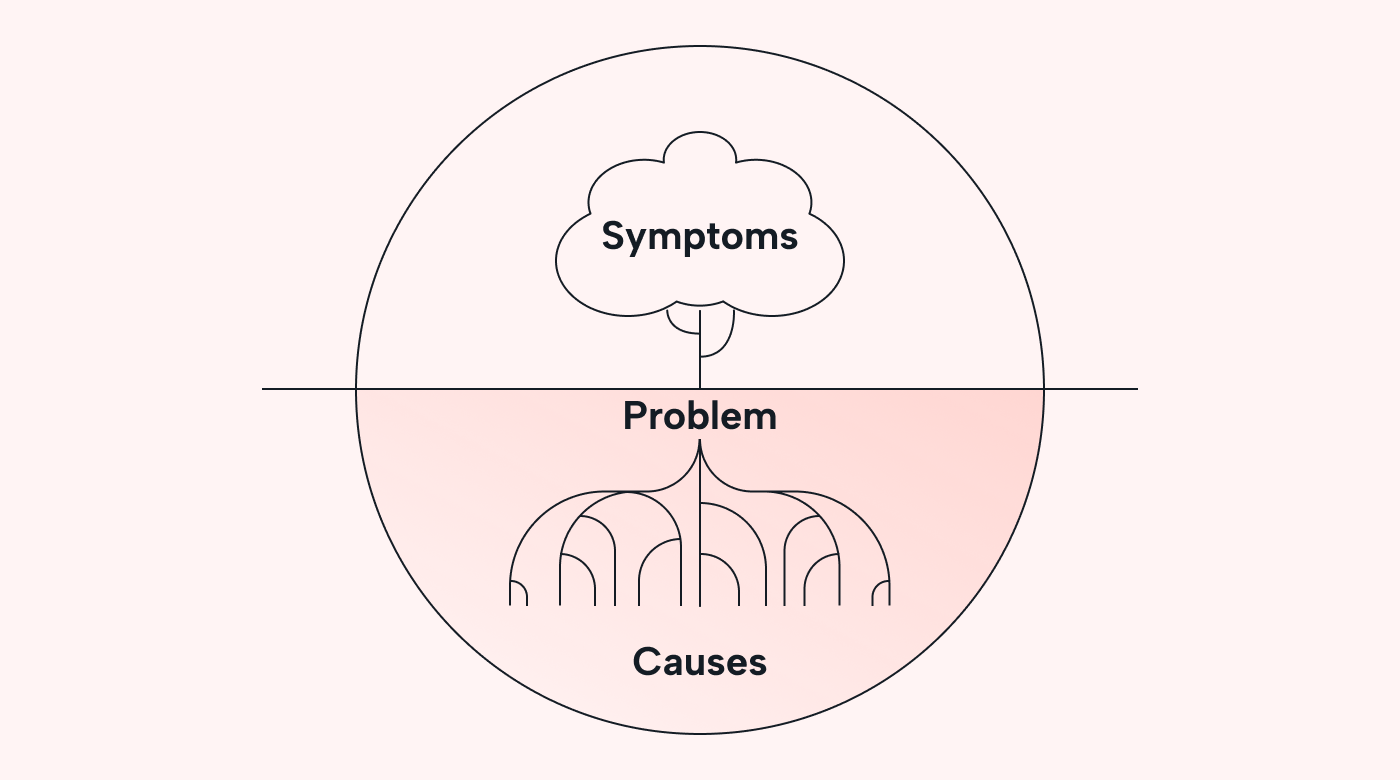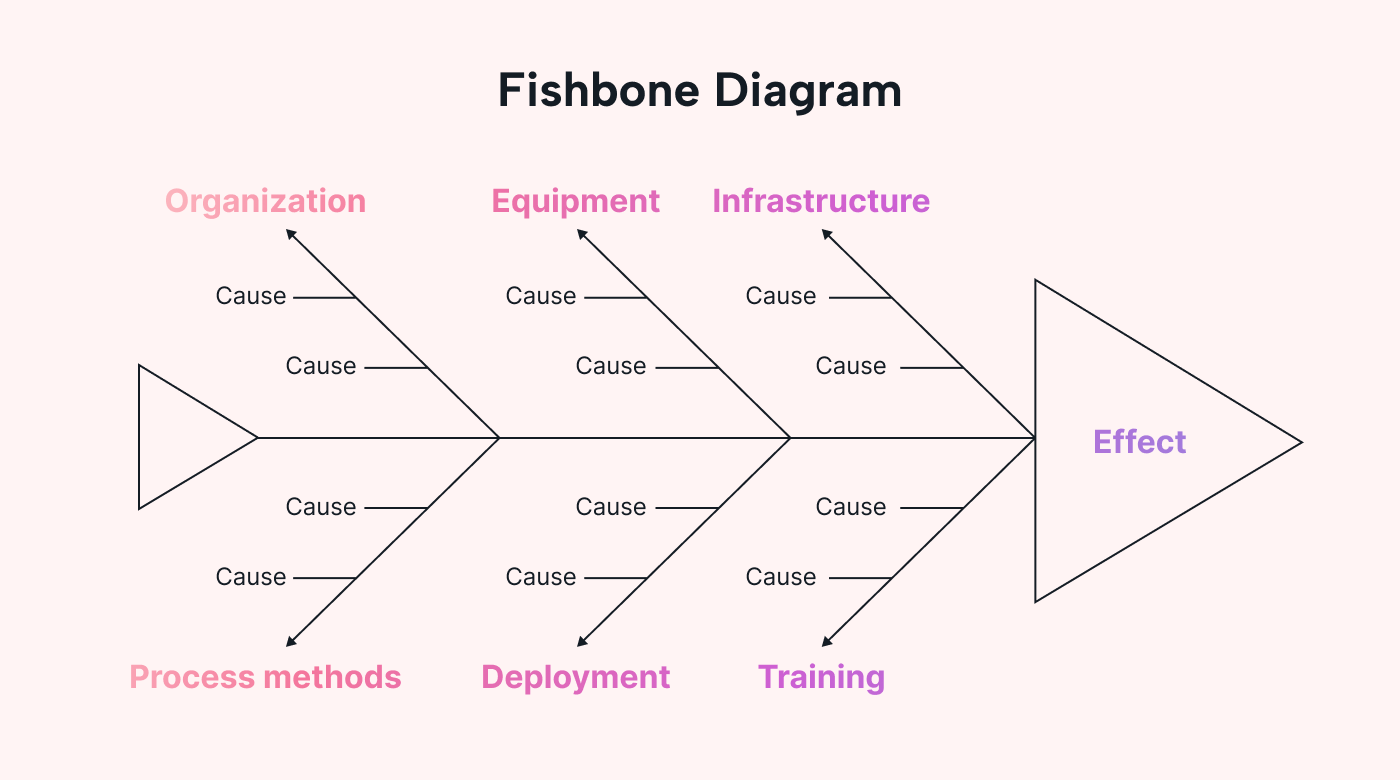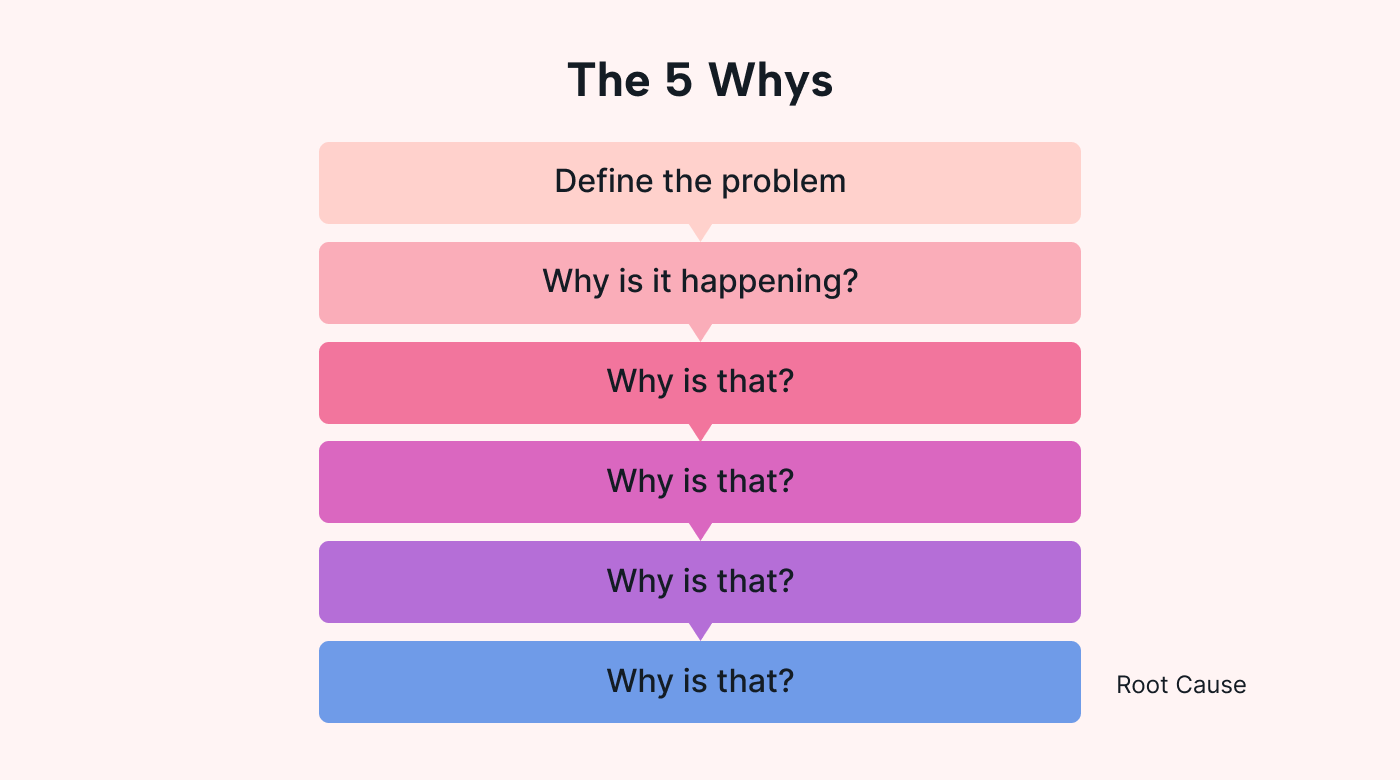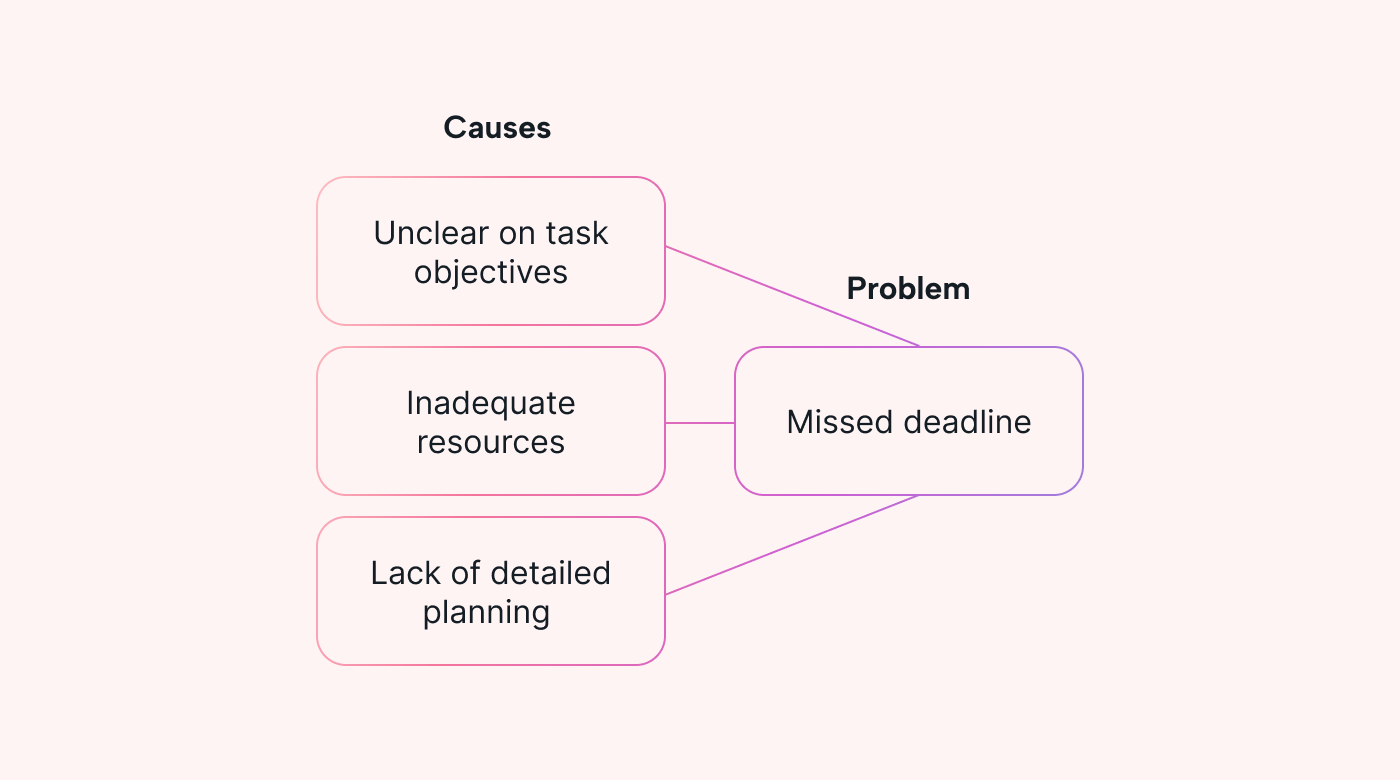Are you constantly dealing with the same issues in your business? Putting in the effort and resources to solve a problem only to see it reappear a few weeks or months later?
If this sounds familiar, you’re not alone. Many managers grapple with frustrating and costly repeat problems.
Fortunately, a framework exists that can help address this issue. It’s called root cause analysis.
Root cause analysis is a problem-solving method that aims to identify the fundamental cause of a problem so that you can create a solution that fixes it for good.
In this article, we’ll give you an in-depth understanding of root cause analysis, including what it is, its benefits, and its common methodologies. Then, we’ll walk you through a step-by-step root cause analysis guide, clear up some common myths, and offer a few essential tips.
With that knowledge in hand, you’ll be able to solve problems once and for all.
Let’s dive in.
Understanding root cause analysis
Let’s discuss what root cause analysis is and explain how it differs from treating the symptoms of a problem.
What is root cause analysis?
Root cause analysis is the process of identifying the underlying issues behind an organizational problem.
Think of it as a detective’s investigation. It’s not asking, “What happened?” but “Why did it happen?”
The causes that could be at play include the following:
- Physical causes: These are tangible issues, like a software bug or a machine breaking.
- Human causes: These are tied to people’s actions, such as human error, negligence, or lack of training.
- Organizational causes: These are linked to bigger-picture issues, like operational inefficiencies, policies, or cultural problems.
Looking into root problems is common in many industries, including healthcare, manufacturing, and IT.
Imagine you run a small business, and the business is struggling with late deliveries.
The late deliveries are what’s happening. But the real issue — or root cause — is something different. Here are examples of physical, human, or organizational causes that could be at play:
Physical: Your delivery vehicles are old and unreliable.
Human: Your drivers need better training.
Organizational: Your delivery scheduling system is inefficient.
How do root causes differ from symptoms?
Symptoms are the expression of a problem. They’re not the problem’s origin — rather, they’re the pain points that show you something’s wrong.
Symptoms can include the following:
- A reduction in productivity
- An increase in the frequency of errors
- A customer complaint
 |
Root causes, on the other hand, are the hidden factors that drive these visible issues.
For example, losing customers is a symptom. Figuring out why this issue is happening leads you to the root cause — which, in this case, might be poor customer service or an inferior product.
Unveiling the benefits of root cause analysis
Root cause analysis is more than a problem-solving method. It’s a strategic approach that enables your business to avoid getting stuck in a cycle of recurring problems.
Essentially, you can work through issues, learn from them, and move forward, which leads to better productivity, fewer roadblocks, and a clearer path to success.
Better efficiency and productivity
Identifying the root cause means you tackle the inefficient processes and broken operations that are bringing about symptoms. That leads to time savings and improved performance.
For example: if a manufacturing plant has too many machine breakdowns from a lack of maintenance, then you need to address the root cause (the lack of maintenance). So, you set up a maintenance schedule to streamline production and improve delivery rates.
Fewer recurring problems
Since root cause analysis confronts the problem at its source rather than treating the symptoms, problems are fixed and don’t reoccur. That reduces the time and resources spent on repeat fixes.
Considering that 85% of C-suite executives believe their organizations are poor at diagnosing problems, mastering root cause analysis could be a game-changer for a lot of companies.
Better bottom line
Root cause analysis does require a time investment, but it’s important to remember that fixing your recurring problem can impact your bottom line, too.
Think about an online retail shop experiencing high return rates. Through root cause analysis, they might determine the cause of this problem is an inaccurate product description.
The business could make a big dent in its return rates by editing the product description on its website — ultimately improving its profit margin.
The methodologies of root cause analysis
There are multiple ways to practice root cause analysis. Each methodology has a set of benefits and best scenarios for use. Let’s look at a few of them below.
The 5 whys
The 5 whys methodology is just as straightforward as it sounds.
In it, you ask five “why” questions to drill down to the root cause of a problem.
Let’s play out an example:
Say your website's conversion rate has significantly dropped. We might ask the following 5 whys:
- Why has the conversion rate dropped? Because fewer people are clicking the “purchase” button.
- Why are fewer people clicking the purchase button? Because they’re abandoning their shopping carts.
- Why are they abandoning their shopping carts? Because the checkout process is too complicated.
- Why is the checkout process too complicated? Because it’s not intuitive, and there are too many steps.
- Why are there too many steps, and why isn’t it intuitive? Because we didn’t consider the user experience when we designed the website.
It may take a bit of time to answer each question effectively. But the 5 whys is a great method for getting under the layers of symptoms to find the root cause.
Fishbone diagram
The fishbone diagram, also known as the Ishikawa diagram, is a visual root cause analysis methodology. It helps identify all possible causes of a particular problem. It’s most useful for complex issues in which multiple causal factors might be involved.
 |
Here’s how it works:
- The “head” of the fish skeleton is where the problem is stated.
- The major “bones” of the fish are the cause categories, such as equipment or infrastructure problems.
- The “branches” coming out of each bone list the causes within each category.
The fishbone method encourages team brainstorming and provides a clear visual representation of the potential root causes.
For example, if you’re experiencing high turnover, you could create the following categories for the cause of the problem: “work environment,” “compensation and benefits,” and “training.” Then, list the problems within each one until you start to uncover the root causes.
Cause-and-effect matrix
The cause-and-effect matrix is a more complex method. But, like the others, it’s beneficial in certain circumstances.
This method involves listing all possible causes and then ranking them based on their severity and frequency. The result is a prioritized list of potential root causes to investigate.
Think about a small restaurant receiving customer complaints about long wait times. They could list potential causes of this issue, such as being understaffed, cooking too slowly, or having delayed suppliers. Afterward, they’d rank each cause to determine which is affecting wait times the most.
Implementing root cause analyses: a step-by-step guide
Now, we’ll cover the basic steps to executing an effective analysis.
Step 1: Identify the problem
The first step is to clearly define the problem, being as specific as possible.
Step 2: Gather data
Next, gather as much relevant information about the problem as possible.
This could include the following:
- When the problem started
- How often the problem occurs
- The conditions under which the problem happens
- Who or what the problem affects
The more comprehensive your data is, the better equipped you’ll be to find the root cause of your problem.
Step 3: Identify possible causes
Once you’ve gathered all the necessary data, start brainstorming possible causes of the problem you’re experiencing.
Here, you can apply one of the methodologies discussed earlier, such as the 5 whys or the fishbone diagram.
Encourage your team to suggest any cause that comes to mind. That way, you can generate a wide range of possibilities to work from.
Step 4: Determine the root cause
Now it’s time to analyze and identify the root cause of the problem.
 |
You may need to conduct more in-depth data analyses, interviews, or observations. Don’t rush this step. It’s vital to confirm that the identified cause is indeed the root cause. If it’s not, the problem will likely continue.
Step 5: Develop and implement a solution
The next step is to develop a solution that addresses the root cause you just discovered.
You want your solution to be action-oriented, specific, and time-bound
Step 6: Monitor the results and make adjustments as needed
You can’t simply put a solution in place and then walk away. Track the solution’s effects, and steer your course where necessary.
Remember to document your root cause analysis process and results. This will not only provide a record for future reference but will also help establish a culture of learning and continuous improvement.
Common objections and misunderstandings
Root cause analysis is a potent tool in the problem-solving toolkit, but it’s not without misconceptions and challenges. Understanding these things can help you more effectively navigate your root cause analysis journey.
Let’s debunk some common myths and offer tips for overcoming potential obstacles.
Myth 1: Root cause analysis isn’t worthwhile
While the root cause analysis method does require effort and time, the potential return on this investment is significant. The time you spend identifying the root cause of a problem can end up saving many hours addressing recurring issues.
Also, not all methods are time-consuming and complex. Techniques like the 5 whys, for instance, can be quick and easy to apply.
Pro tip: Start with simple root cause analysis techniques, like the 5 whys, and gradually move to more complex ones later if you wish.
Myth 2: Only large organizations benefit from root cause analysis
That couldn’t be further from the truth. Small businesses stand to benefit significantly from a root cause analysis. This technique can help identify inefficiencies and improve business processes, both of which are vital for lean operations and competitiveness.
Pro tip: Don’t think about the size of your business as much as the complexity of your problem and the resources you have available.
Myth 3: Root cause analysis always reveals one clear cause
Some problems can have multiple root causes, and it’s essential to address all of them to find a comprehensive solution.
 |
Pro tip: If you think your problem has multiple causes, try the fishbone diagram analysis. It’s great for getting a multifaceted view of the issue.
Embracing root cause analysis as a proactive tool
As with many business strategies, there are ways to go deeper with root cause analysis. Here are some points to keep in mind:
It’s not just for problems
While root cause analysis does solve problems, it can also help you understand why things are going well when they do.
This can be valuable for scaling success.
For instance, if you find one of your marketing campaigns to be particularly successful, a root cause analysis could help identify the reason(s) behind that success. You could then replicate those factors in future campaigns.
It can reveal deeper organizational issues
Root cause analysis can bring systemic issues to light.
What might seem like a standalone problem could really be an indicator of underlying organizational challenges, such as communication gaps or inadequate training.
Don’t be afraid to go in-depth with your analysis to find bigger problems at the organizational level. While these issues can be troubling to find, think of them more as an opportunity.
It can foster a culture of continual learning and improvement
Root cause analysis encourages teams to investigate problems.
Rather than patching up issues superficially, you can create a culture in your organization that asks, “Why is this happening?”
This mindset can go beyond simple problem-solving to have far-reaching benefits.
Level up your problem-solving with Motion
Root cause analysis is an incredibly powerful tool for any organization. It’s not just about troubleshooting — it’s about addressing your business’s challenges at their source.
Motion can eliminate many scheduling and task management issues before they even arise. Our advanced calendar can streamline your project and task management.
Take your problem-solving to the next level using Motion’s AI software. Sign up for our 7-day free trial today!





